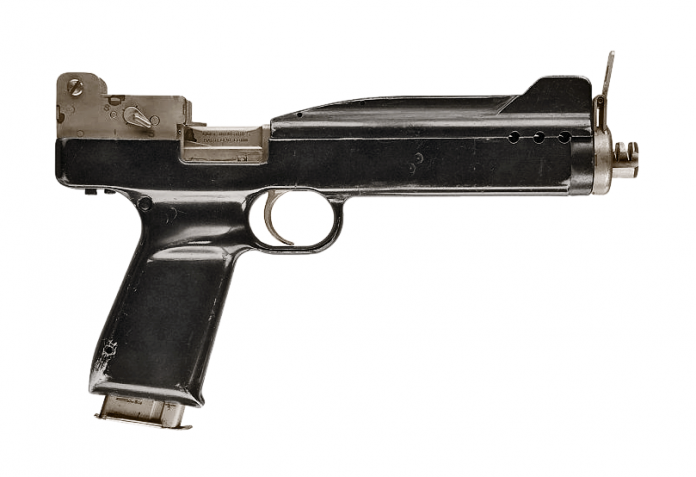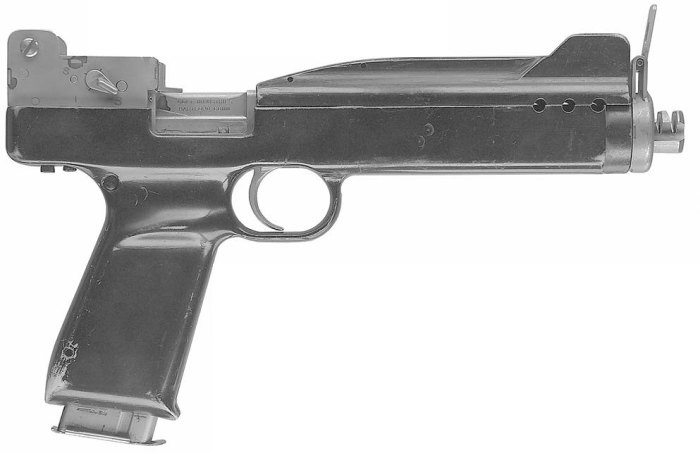
Machine pistols are fickle beasts. They are rarely effective firearms and come and go quite quickly. The problems typically deal with control and fire rate. They are tough to handle, recoil excessively and don’t provide decent accuracy. Dedicated submachine guns often work much better, even when they are insanely small. Back in the late 1960s, Colt developed the Scamp, which might have been the first effective machine pistol.
In 1969 Colt tried to predict the future. The M1911A1 had been in service for a lonnnggg time, and they wisely figured, let’s start working on a replacement. Colt went in a very odd direction when they developed the Scamp. Even then, we kind of knew that handguns suck in fights, at least compared to rifles, machine guns, shotguns, etc.
Pistol rounds just don’t kill well, so Colt focused on the future. The M16 proved smaller calibers were capable, arm’s designers were looking towards the future. Thus the Colt Scamp was born. Colt wanted a machine pistol and began examining small SMGs and machine pistols that proved worthwhile. Notably, guns like the Vz. 61 Skorpion.
The Colt Scamp
Scamp might be a fun name for a mischievous little kid, but it’s also an acronym. Scamp stands for Small Caliber Machine Pistol. In 1971 Colt produced the first and only prototype. The pistol would be a gas-operated, locked-breech pistol with select-fire capability. The Scamp would feature a safe, semi, and three-round burst mode. The burst mode fired between 1,200 and 1,500 rounds per minute, so it was quite fast.
Much like the M16, Colt’s little blaster utilized space age goodness to bring the gun to the next level. This included a glass-reinforced polymer design that contained all stainless moving parts. This helped keep weight low.

The Scamp measured 11.6 inches long, with a long 9.12-inch barrel. The weapon weighed 2.25 pounds unloaded and 3.24 pounds fully loaded. In 1971 double stack pistols were not all that common. The Hi-Power existed for decades by now, but people really loved single stacks. Colt figured a machine pistol needed an impressive magazine size, and the Scamp utilized a 27 round mag. Shooters got nine bursts from the gun.
Control Matters
Control was a major factor, and Colt utilized three different ways to help make the Scamp controllable. First, they added that three-round burst mode which would limit the full-auto fire. Second, they lowered the bore as much as possible. Third, they added a compensator.
Coot installed a set of windage adjustable sights for precision shooting. On top of that, they installed what’s described as a quick-point aiming rib for reactive combat shooting. According to a few folks who shot the Scamp, they all described it as easy to shoot and controllable.

Additionally, the gun became known for its accuracy, range, and flat shooting design. Colt officials were pleased with the weapon’s performance during military trials.
The Caliber
Colt wanted to stray from your average pistol caliber. Instead, they looked at the .223 Remington. Obviously, it’s much too big for a handgun, but the spitzer bullet design in a handgun seemed promising. They looked at the short and fast .221 Remington Fireball and went from there.

The Colt .22 Scamp was born. The round would be a bottleneck design with a 40-grain bullet. While not the intention at the time, the round’s design and 2,100 FPS speed would make it an effective PDW cartridge. It would likely have no problems chewing through a soft armor vest.

Unlike most handgun rounds, the .22 Scamp could reach out to 100 yards while remaining flat shooting. In the 1970s, this was revolutionary. I imagine should the Scamp have gone anywhere, this caliber would be used in SMGs, and the Scamp fitted with stock could be a viable short weapon.
The Future of the Scamp
As I stated, only Scamp ever saw production. As you can assume, the Scamp didn’t have much of a future. The Army wasn’t keen to replace the M1911 just yet, and we know now the gun wouldn’t be replaced till 1985. The weapon performed well but wasn’t wanted at the time.
The Air Force looked at the Scamp when searching for a survival weapon for aircrews. This was at a time where the Air Force was looking at some odd guns like the Davis Gun. Yet, they didn’t show any long-term interest.
Sadly, after that, the pistol and the .22 Scamp went into Colt’s prototype vault, where it sits today. I like to picture a world where I packed a Scamp in a SERPA during my time in the Marine Corps, and I lovingly looked back at the experience. Yet here we are, and only now has the military adopted a polymer frame pistol, so the Scamp didn’t have a chance.



